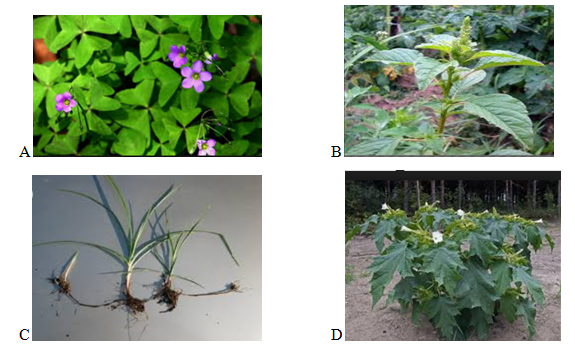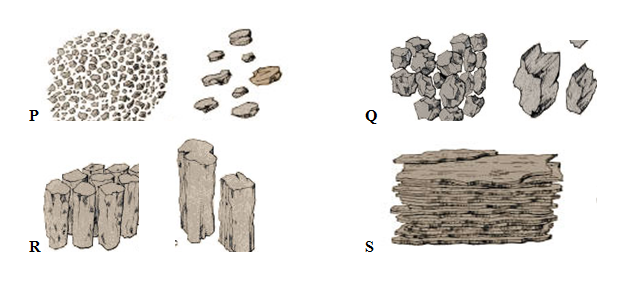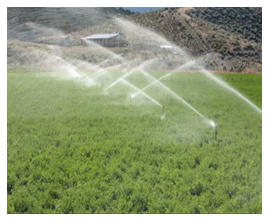SECTION A- (30 MARKS)
Answer all questions in the spaces provided
- State the three forms in which horticulture is practiced in Kenya (11/2 marks)
- Identify two ways in which agriculture support agro based industries (1 mark)
- List down three biotic factors that influence agriculture negatively (11/2marks)
- Name any three crops that can be propagated by use of suckers (11/2marks)
- Outline four roles of trees in soil conservation (2 marks)
- Identify two examples of intensive farming systems practiced in crop production (1 mark)
- Outline fourways in which living organisms contribute to soil formation (2 marks)
- Give four reasons that may necessitate sub soiling to be carried out on a piece of land (2 marks)
- Name any four physical methods of water treatment (2 marks
- Give three reasons why green manure is not commonly used (11/2marks)
- Name two types of labour records that can be kept by a large scale plantation farmer. (1 mark)
- Outline four areas that should be avoided when collecting a soil sample for testing (2 marks)
- Differentiate between a seed bed and a seedling bed (1 mark)
- Name three field practices that are used to support weak stemmed crops (11/2marks)
- Give four reasons that would make a farmer chose a jembe during land preparation over a disc plough (2 marks)
- Give a reason why use of organic manure is discouraged in carrot production (1 mark)
- Outline four advantages of zero grazing as a system of grazing (2marks)
- Identify four sources of credit facilities where one can get capital to carry out crop production (2 marks)
- Name any three fertilizer elements (11/2 marks)
SECTION B (20 MARKS)
Answer all questions in this section.
- The following are photographs of weeds obtained from the farm
- Identify the weeds (2 marks)
- State one major disadvantage of weed labeled A (1 mark)
- Give two reasons why weed C is difficult to control. (1 mark)
- State one economic importance of the weed labeled (B) to human beings (1 mark)
- The table below shows weekly demand for rice in am market
Price (ksh) Quantity demanded (kgs)
10 250
9 350
8 550
7 600
6 700
5 1000
4 1500- Calculate the elasticity of demand (Ed) for rice when the price falls from Kshs. 10 to Kshs. 9 per Kg. (show your working) (3 marks)
- Other than price state any other factor that may factor that may increase the demand for rice in the market (2 marks) The following diagrams shows various samples of soil aggregates
- Identifythe type of soils structures (2marks)
- Briefly explain how soil structures P can be improved (1mark)
- Name two places where soil structure labeled S can be found (2 marks)
- Study the following photographs and use them to answer the question that follows
- Identify the type of irrigation shown in the photograph (1 mark)
- State any two advantages of the above method of irrigation (2 marks)
- Other than the one shown above identify any other two methods that a farmer can use to irrigate his crops (2 marks)
SECTION C – 40 MARKS)
Answer any two questions and answer them in the spaces provided after question 26
- A farmer has 30 hectares of arable land,20 hectares of which is planted withmaize and 10hectares with grass hay. He wishes to replace 10 hectares of maize with Irish potatoes next year. The fertilizer rate will have to be increased from 2 bags per hectare for maize to 4 bags per hectare for potatoes. As a result of the change extra 40 men days of casual labour per hectare will be necessary at the rate of Kshs.100 per man a day. The average yield per hectare of maize is 35bags and for potatoes 120bags.The price paid is Kshs.1, 000 per bag of maize and Kshs.600 per bag of potatoes. Maize seeds cost Kshs.750 per hectare and potatoes cost Kshs.800 per hectare. Fertilizer costs are Kshs. 650 per hectare.
- Draw up a partial budget and advice the farmer accordingly. (9 marks)
- Name the other type of budget that can be prepared by a farm manager (1 mark)
-
- Discuss the various problems associated with land fragmentation (6 marks)
- Explain four environmental factors that affect the effectives of herbicides (4 marks)
-
- Discuss the various cultural practices carried by farmers to control pests (10marks)
- Discuss the production of dry beans under the following headings
- Varieties (2 marks)
- Section of planting materials (3 marks)
- Postharvest practices of dry beans (5 marks)
-
- Describe harvesting of pyrethrum under the following subheading
- Method and procedure (3 marks)
- Precautions (3 marks)
- Statefive characteristics of nitrogenous fertilizers (4marks)
- Explain fivefactors to consider when designing a crop rotation programme (10 marks)
- Describe harvesting of pyrethrum under the following subheading

MARKING SCHEME
Section A- (30 marks)
- State the three forms in which horticulture is practiced in Kenya (11/2 marks)
Olericulture
Pomoculture
Floriculture - Identify two ways in which agriculture support agro based industries (1 mark)
Sources of raw materials to industries
Source market for processed goods - List down three biotic factors that influence agriculture negatively (11/2 marks)
Predators
Pests
pathogens - name any three crops that can be propagated by use of suckers (11/2 marks)
pineapples
sisal
bananas - Outline four roles of tress in soil conservation (2 marks)
Tree roots bunds soil particles together reducing erosion
Tree leaves intercept raindrops preventing splash erosion
Tree acts as wind breakers lowering erosion by wind
Tree leaves falls and decomposes improving soil structure and fertility - Identify two examples of intensive farming systems practiced in crop production (1 mark)
Green house farming
Plantation farming - Outline ways in which living organisms contribute to soil formation (2 marks)
Large animals exerts pressure on rocks causing them to break
Human activities such as mining, quarrying construction and cultivation
Bacteria and fungi decomposes within the soil
Earthworms feeds on plants tissues cementing the soil particles
Plant roots exerts pressure on rocks making them to crack
Root produces acids in the soils during respiration which dissolves mineral from rocks - Give four reasons that may necessitate sub soiling to be carried out on a piece of land (2 marks)
To promote soil aeration/gaseous exchange
To bring leached minerals to the soils surface
To promote water infiltration/ prevent water logging
To encourage crop root penetration - Name any four physical methods of water treatment (2 marks)
Boiling
Sedimentation
Filtration/sieving
Decantation - Give three reasons why green manure is not commonly used (11/2 marks)
Most of the crops used are food crops
Green manure use most the soil moisture leaving very little for the next crop
It takes time to prepare hence delaying planting
Most nutrients are lost during decompositions by microorganisms - Name two types of labour records that can be kept by a large scale plantation farmer. (1marks)
Muster roll
Labour utilization record - Outline four areas that should be avoided when collecting a soil sample for testing (2 marks)
Dead furrows
Old fence lines
Old manure heaps
Swampy areas
Under trees and boundaries
Anthills - Differentiate between a seed bed and a seedling bed (1 marks)
Seedbed – piece of land prepared to receive planting materials while
Seedling bed – a special nursery bed for raising seedlings which has been removed from an overcrowded nursery (mark as a whole) - Name three field practices that are carried out to support weak stemmed crops (11/2 marks)
Propping
Trellising
Staking - Give four reasons that would make a farmer chose a jembe during land preparation over a disc plough (2 marks)
Small piece of land
Inadequate capital
Inaccessible land
Steep slopes (rej. Topography)
Unavailability of disc ploughs/tractors/ lack of skills
(note underline words) - Give a reason why use of organic manure is discouraged in carrot production (1 marks)
It causes forking in carrots - Outline four advantages of zero grazing as a system of grazing (2marks)
Faster accumulation of manure
Animals utilizes feeds without wastage
High yields since less wastage of energy due to restricted movement
Easy to control parasites and disease
Requires little land
High stocking rates - Identify four sources of credit facilities where one can get capital to carry out crop production (2 marks)
Cooperative societies
Agricultural finance corporation
Commercial banks
G.Os
Insurance companies
Individual money lenders - Name any three fertilizer elements (11/2 marks)
Nitrogen
Phosphorus
Potassium
Section B (20 marks) - The following are photographs of weeds obtained from the farm
- Identify the weeds (2 marks)
Oxalis latifolia (oxalis
Amarantus hybridus (pigweed
Cyperus rotundus (nut grass)
Thorn apple (Datura stramonium) - State one major disadvantage of weed labeled A (1 mark)
Acts as an alternative host for rust disease - Give two reasons why weed C is difficult to control. (1 mark)
Has underground structures called rhizomes that propagate vegetatively - State one economic importance of the weed labeled (B) to human beings (1 mark)
Used as a source of food
- Identify the weeds (2 marks)
-
- Calculate the elasticity of demand (Ed) for rice when the price falls from Kshs. 10 to Kshs. 9 per Kg. (show your working)
Percentage = % change in quantity demanded (√) mark
% change in price of the commodity
% change in quantity = 350 -250 x 100 = 40% (√) mark
250
% change in price = 9-10 x 100 = 10%
10
Ed= 40 = 4 (√) mark
ALTERNATIVE B
Decrease in price from kshs 10 to ksh 9
Ed = Change in quantity demanded x original price
Change in price original quantity demanded(√) mark
= (250-350) x 10 (√) mark
9-10 250
= 4 (√) mark - Identify the type of soils structures represented by diagram (a and C) (2 marks)
P Single grained
Q Blocky
R Prismatic
S Platy - Briefly explain how soil structures P can be improved (1 marks)
Addition of organic manure binds soil particles together hence improving the soil structure - Name two places where soil structure labeled S can be found (2 marks)
Cattle bomas/sheds
Forests soils
- Calculate the elasticity of demand (Ed) for rice when the price falls from Kshs. 10 to Kshs. 9 per Kg. (show your working)
- Identify the type of irrigation shown in the photograph (1 marks)- (a tied question if identity is wrong don’t mark part b and c)
Overhead/sprinkler irrigation- State any two advantages of the above method of irrigation (2 marks)
Can be used in steep areas
Can be used to apply pesticides together with irrigation water
Water is evenly distributed - Other than the one shown above identify any other two methods that a farmer can use to irrigate his crops (2 marks)
Drip irrigation
Flood irrigation
Basin irrigation
Section C (40 marks)
- State any two advantages of the above method of irrigation (2 marks)
-
- A farmer has 30 hectares of arable land,20 hectares of which is planted withmaize and 10hectares with grass hay. He wishes to replace 10hectares of maize with Irish potatoes next year. The fertilizer rate will have to be increased from 2 bags per hectare for maize to 4 bags per hectare for potatoes. As a result of the change extra 40 men days of casual labour per hectare will be necessary at the rate of Kshs.100 per man a day. The average yield per hectare of maize is 35bags and for potatoes 120bags.The price paid is Kshs.1, 000 per bag of maize and Kshs.600 per bag of potatoes. Maize seeds cost Kshs.750 per hectare and potatoes cost Kshs.800 per hectare. Fertilizer costs are 650 per hectare.
- Draw up a partial budget and advice the farmer accordingly. (10marks)
DEBIT (-) ((√) 1 marks CREDIT (+) (√) 1 marks
740,500 – 424,000 = 316,500 (√) 1 marks(Extra revenue + cost saved ) – (Extra cost + Revenue foregone)Extra cost
Irish potatoes
i) Fertilizer
4x10x650
ii) Labour
40x10x100
iii) Seeds
800x10
Revenue foregone
i) Maize yield
35x10x1000
ii) Extra cost + Revenue foregone
Shs
26,000(√)1/2
40,000(√)1/2
8,000(√)1/2
74,000
350,000(√)1/2
424,000((√) 1 marks
Cts
00
00
00
00
00
00
Extra revenue
Irish potato yield
120x10x600
Cost saved
Maize
i) Seed
750x10
ii) Fertilizer
2x10x650
Extra Revenue + cost saved
Shs
720,000(√)1/2
7,500(√)1/2
13,000(√)1/2
740,500((√) 1 marks
Cts
00
00
00
00
The farmer should go ahead with the change because credit is more than debit by 244,500(√)1/2 - Name the other type of budget that can be prepared by a farm manager. (1 mark)
Complete budget
- Draw up a partial budget and advice the farmer accordingly. (10marks)
- Discuss the various problems associated with land fragmentation Any 6x1=6marks)
Time wastage travelling from one fragment to another
Difficult to control weeds since neighbour may be neglected
Lack of sound farm planning due to distance between fragments
Poor supervision of scattered plots
Difficult carrying out soil and water conservation measures
Overstocking soil erosion and denudation incase the plot is not fenced due to communal grazing
Difficult to acquire agricultural extension advices - Explain four environmental factors that affect the effectives of herbicides (4 marks)
Wind – blow away herbicide to unwanted places
Rain – dilutes herbicides lowering its effectiveness
Soil – some absorbs herbicides hence more doses for herbicides to be effective
Temperature – increases translocation/absorption of herbicides hence death of the plant (stating ½ marks, explaining ½ marks)
- A farmer has 30 hectares of arable land,20 hectares of which is planted withmaize and 10hectares with grass hay. He wishes to replace 10hectares of maize with Irish potatoes next year. The fertilizer rate will have to be increased from 2 bags per hectare for maize to 4 bags per hectare for potatoes. As a result of the change extra 40 men days of casual labour per hectare will be necessary at the rate of Kshs.100 per man a day. The average yield per hectare of maize is 35bags and for potatoes 120bags.The price paid is Kshs.1, 000 per bag of maize and Kshs.600 per bag of potatoes. Maize seeds cost Kshs.750 per hectare and potatoes cost Kshs.800 per hectare. Fertilizer costs are 650 per hectare.
-
- Discuss the various cultural practices carried by farmers to control pests (10 marks)
Timely planting – early planted crops are likely to escape pest attck
Proper tillage well prepared land exposes
Timely harvesting – harvesting should not be delayed to enable crops escape pest attack
Close season – a period when a susceptible is grown to control a certain pest
Trap cropping – a crop planted along the main crop that is more preffered by a pest directing the pest from the main crop .
Crop rotation – crops that are more preferred by a particular pest should be rotated with those that are not.Use of resistant varieties – some plants have natural protective mechanisms against pests e.g. some onions and lemons varieties are repellant to pests
Field hygiene – destroying plant materials that harbours pests through rogueing and destruction of infected with pest.
Pruning – removes microclimates that would be favourable for certain pests.
Destruction of alternative host – reduces chances of spread of pest to the main crop
Use of clean planting materials – prevents entries of pests to the fied
Proper spacing – reduces spread of pests from on crop to another
Irrigation – overhead irrigation controls aphids
Crop nutrition – fertilizers and manure added makes crops stronger and resists and escapes attack
(Any 10x1=10 marks) - Discuss the production of dry beans under the following headings
- Varieties (2x1/2=2 marks)
Rose coco
Mwezi moja
Canadian wonder
Wairimu
Mexican 142 - Selection of planting materials (3 marks)
Sort and discard damaged and wrinkled seeds
Seeds should be true to type
Selects seeds that are free from pests and diseases/healthy seeds
Dress seeds to control soil borne pests and disease
Inoculate seeds with rhizobuim phaseoili to promote nodulation - Postharvest practices of dry beans (5 marks)
Thresh/beat the plant with sticks
Remove stems and pods after threshing
Winnow the dry bean seeds - Sort to remove damaged seeds
Dusts the seeds with an appropriate pesticide.
Pack the beans in a dry gunny bags/sacks
- Varieties (2x1/2=2 marks)
- Discuss the various cultural practices carried by farmers to control pests (10 marks)
-
- Describe harvesting of pyrethrum under the following subheading
- Method and procedure (3 marks)
Pick flowers selectively,
Pick only flowers with 2-3 disc florets open (horizontal) petals
Repeat at intervals of 14-21 days - Precautions (3 marks)
Put flowers in open woven baskets for air circulation
Do not pick wet flowers
Do not compact wet flowers
- Method and procedure (3 marks)
- State four characteristics of nitrogenous fertilizers (4 marks)
Highly hygroscopic
Highly soluble in water
Highly corrosive
Highly volatile
Have scorching effect
Short residual effect - Explain five factors to consider when designing a crop rotation programme (10 marks)
Soil fertility-include leguminous crop to fix nitrogen
Soil structure –include grass leys to bind soil particles
Weed control-crops that associated with similar weeds should not be alternated
Root depth-deep rooted crop should be alternated with shallow rooted crops
Crop nutrient requirement-heavy feeder should be alternated with light feeders
Pest and disease control- crops of the same family should not follow each other
- Describe harvesting of pyrethrum under the following subheading
Download AGRICULTURE PAPER 1 - 2019 LAINAKU JOINT MOCK EVALUATION EXAMINATION.
Tap Here to Download for 50/-
Get on WhatsApp for 50/-
Why download?
- ✔ To read offline at any time.
- ✔ To Print at your convenience
- ✔ Share Easily with Friends / Students




